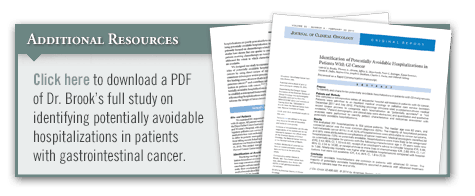Hospitalizations are a distressing experience for patients with cancer and their families, especially when they occur near the end of life. Studies show that hospitalizations are the largest single component of spending for cancer care in the United States. Hospital admissions for patients with cancer vary substantially from region to region. This variability suggests that many hospitalizations are avoidable, according to Gabriel A. Brooks, MD. “Effective strategies to reduce potentially avoidable hospitalizations would increase our ability to provide high-quality, patient-centered care that is conscious of costs.”
Potentially avoidable hospitalizations have been examined broadly in published research, but conclusions from these studies are often poorly generalizable to oncology care. Such studies tend to focus on chemotherapy-related hospitalizations when conducted in patients with cancer. While it has been estimated that as many as one-third of hospitalizations in patients receiving chemotherapy are toxicity-related, these analyses have not addressed the extent to which chemotherapy-related hospitalizations are avoidable.
Looking at GI Cancers
Colorectal and pancreatic cancer are two gastrointestinal (GI) cancers that are among the five leading causes of cancer-related death in the United States. These diseases contribute substantially to inpatient hospitalizations in patients with cancer. In the Journal of Clinical Oncology, Dr. Brooks and colleagues had a study published that examined the incidence and characteristics of potentially avoidable hospitalizations in patients with GI cancers. “Characterizing potentially avoidable hospitalizations in patients with GI cancer will enhance our knowledge base and inform the design of future interventions,” says Dr. Brooks.
In the study, Dr. Brooks and colleagues evaluated 201 hospitalizations in 154 unique patients with GI cancer. Colorectal cancer was the most common diagnosis, and 81% of hospitalized patients had metastatic disease. About 70% of these patients had at least one previous hospitalization in the last year. All totaled, 53% of hospitalizations were attributable to cancer symptoms and 28% resulted from complications of cancer treatment.
“Importantly, our study showed that 19% of hospitalizations for patients with GI cancer were categorized as potentially avoidable after being reviewed by practicing oncologists,” Dr. Brooks says (Table 1). Hospitalizations were more likely to be categorized as potentially avoidable for patients aged 70 and older, for those previously receiving an oncologist’s advice to consider hospice, and for those who had received three or more lines of chemotherapy (Table 2). In addition, the study team found that 90-day mortality was significantly higher after avoidable hospitalizations when compared with hospitalizations that were not deemed avoidable. Patients with potentially avoidable hospitalizations were more likely to be discharged home with hospice.
Examining the Implications
Throughout the U.S., efforts are being made to maintain and expand access to high-quality cancer care while focusing on reducing the growth of cancer treatment costs, Dr. Brooks says. “Hospital care accounts for more than half of all medical spending in patients with advanced cancer. This makes the identification of potentially avoidable hospitalizations a high-impact opportunity to improve the value and quality of cancer care delivery.”
Results from the study have important implications for clinical practice. “Our findings suggest that oncologists perceive that a substantial number of hospitalizations are potentially avoidable, particularly near the end of life,” Dr. Brooks says. “This underscores the potentially large impact of interventions for improving symptom control and patient understanding about the prognosis of advanced cancer.” Taking new patient-centered approaches to reduce the incidence of avoidable hospitalizations can also potentially be cost saving.
Novel Interventions Needed
Interventions to reduce potentially avoidable hospitalizations will need to find ways to foster and support patient-centered cancer care teams without interfering with the therapeutic relationship between patients and oncologists. Clinicians need reliable metrics to measure the impact of new approaches, and Dr. Brooks says that it will be important to measure all hospitalizations in specified patient populations for whom avoiding hospitalizations is especially desirable. “Taking this approach can help medical practices and healthcare systems establish baseline rates of hospital admissions within defined patient groups,” he says. “These institutions can then measure the impact of interventions against their baselines.”
In addition, policy and organizational reforms will be required. Currently, there are few financial incentives for providers to reduce avoidable hospitalizations, and much of the clinical work that is needed to explore interventions for reducing these hospitalizations will likely be uncompensated. “Ultimately, we need to find cost-effective interventions that are tailored for specific settings to effectively avoid hospitalizations,” says Dr. Brooks. “A concerted effort toward improving coordination of care will go a long way toward enhancing outcomes for patients with GI cancers.”




 admin
admin